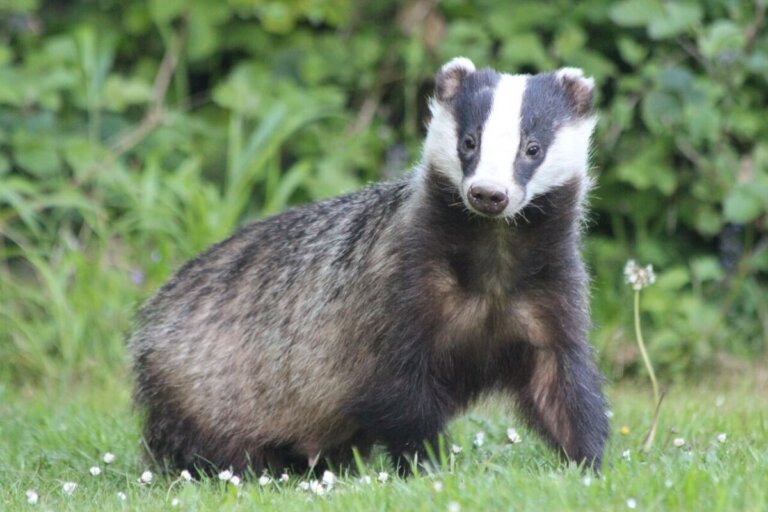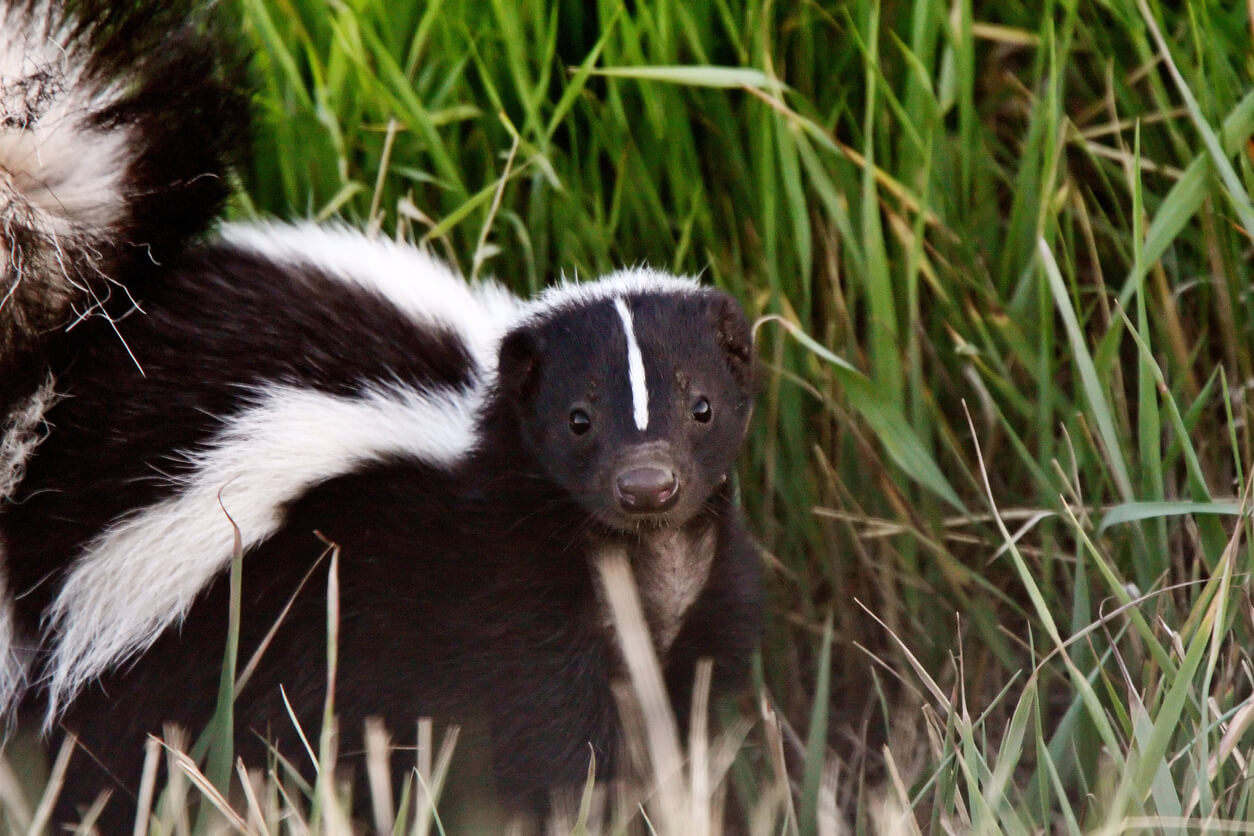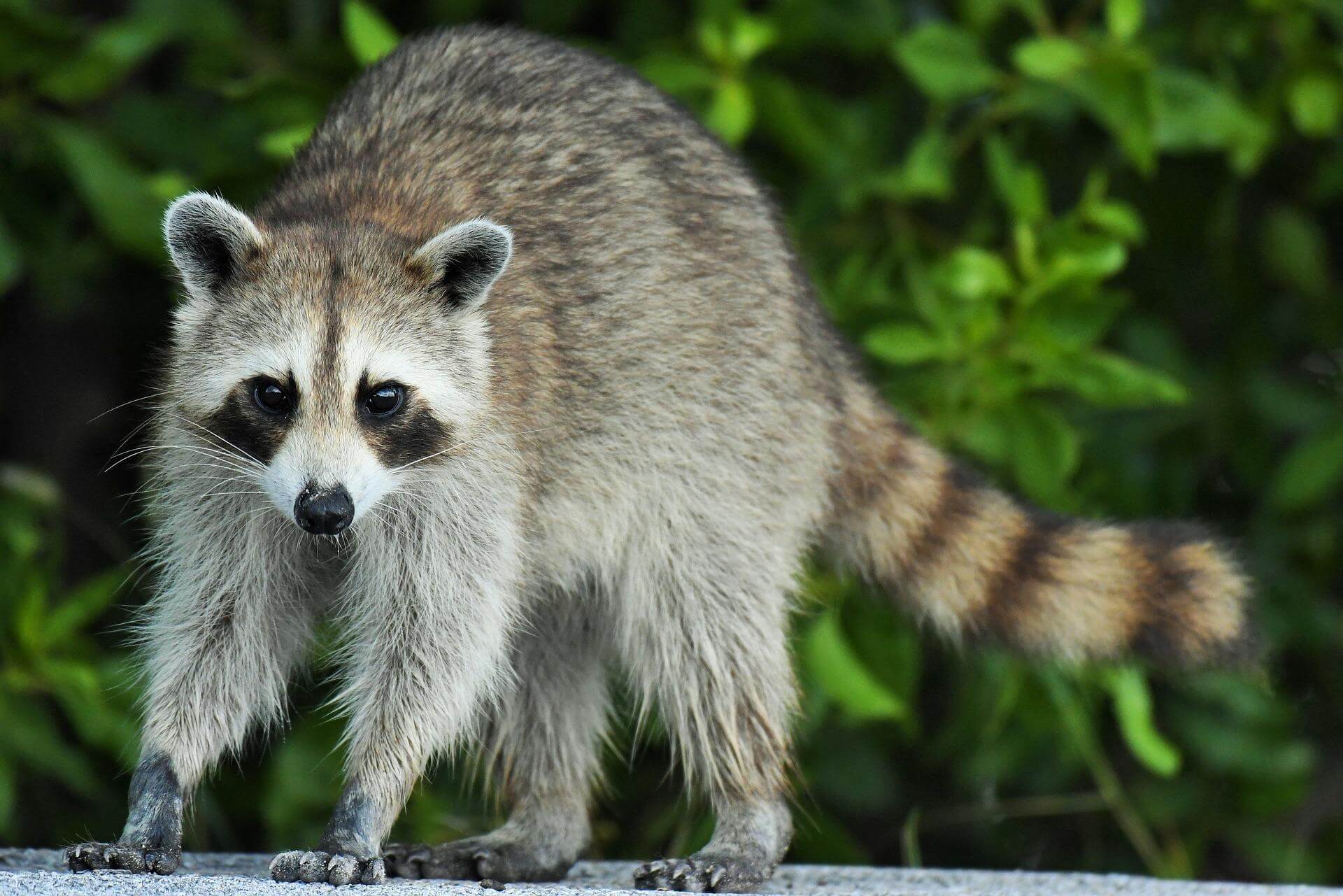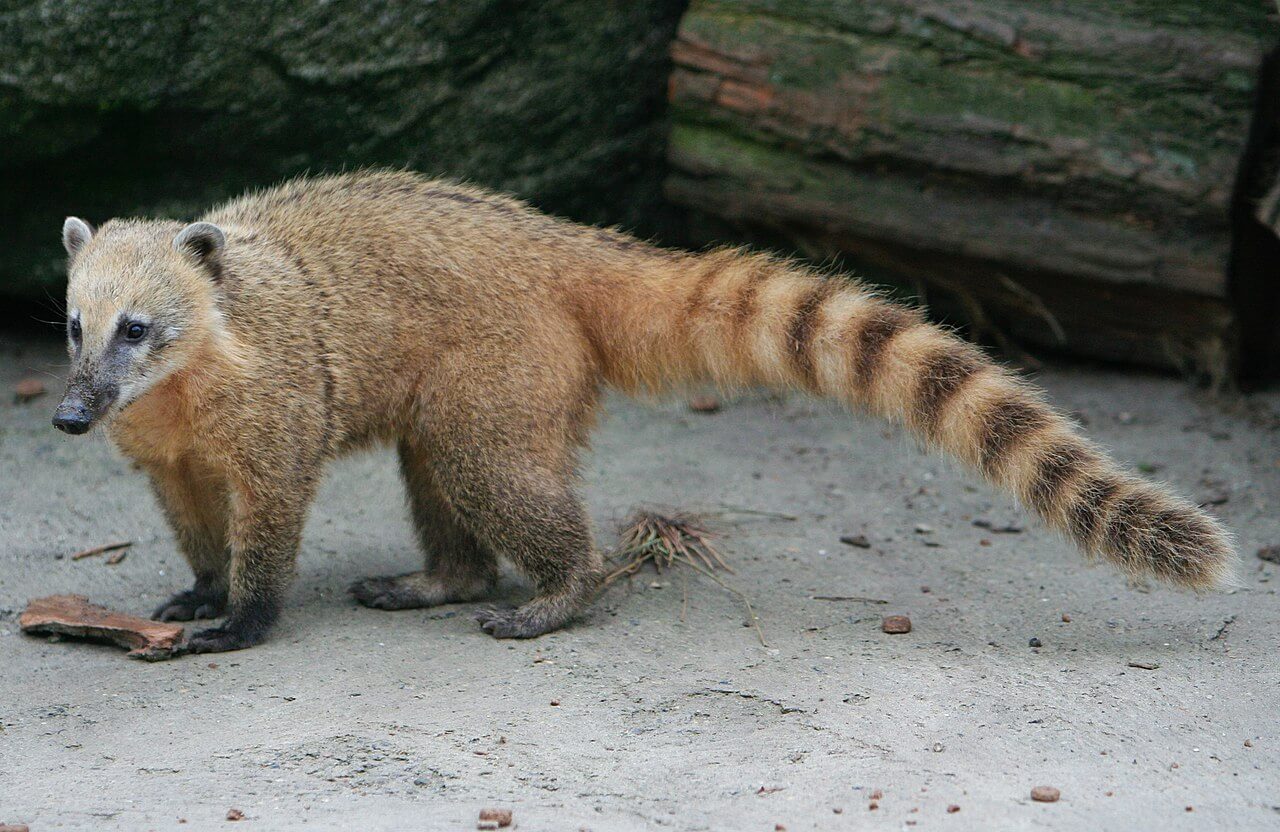Top 3 Animals that Are Mistaken for Badgers


Written and verified by the veterinarian and zootechnician Sebastian Ramirez Ocampo
The common badger, also known as Meles meles – its scientific name – is an omnivorous mammal belonging to the mustelid family. It’s found in North America, Europe, Asia, and even sub-Saharan Africa and the Middle East. Given their morphology, there are other animals that can be found in the wild that are easily mistaken for badgers. However, these share little or nothing with the nature and phylogenetics of this species.
If you want to know more about these animals and how to tell them apart, don’t miss the information in the following article. Keep reading!
The characteristics of badgers
Before exploring the animals that are often mistaken for badgers, we need to be aware of the characteristics of this species to know how it differs from others. With that said, let’s get going!
The morphology of badgers
According to the Virtual Encyclopedia of Spanish Vertebrates, the badger is a medium-sized animal. In adulthood, its body measures between 23.5 and 39 inches. Likewise, its weight ranges between 10.5 to 21 pounds.
Fossorial habits–adaptation to digging and living in underground caves–determine the shape of this animal’s anatomy. Accordingly, its morphology is distinguished by the following characteristics:
- A short neck
- An elongated snout
- A small but robust head
In addition, this species, belonging to the mustelid family, has strong extremities that end in powerful, non-retractable claws, for rapid digging. In addition to this, the snout has small hairs that serve as a tactile organ, as the animal’s sense of vision is poorly developed.
The badger stands out for the strength of its jaw and the ability to close its ears during digging.
The color of its body is grayish in the dorsal part and darker in the ventral part. In addition, it has a very characteristic pattern on the face, consisting of a white background furrowed by two black bands that cover the eye area, similar to a mask.
Habitat
Badgers inhabit a wide variety of ecosystems. In this regard, it has a preference for the following:
- Semi-arid environments.
- High mountain areas.
- Lush forests with grasslands (where it can establish its badger dens).
Inside these impressive burrows – which can be up to 100 meters long and have more than 40 entrances and exits – they spend up to 70% of their wild life.
According to a publication in the journal Animals, badgers are considered to be great ecosystem engineers. This is because, by creating these structures, they bring to life new microhabitats that allow many plant and animal species to establish themselves. In fact, badger settlements are places with increased biodiversity.
Feeding
It’s an omnivorous animal, although its diet is carnivorous, for the most part. In the wild, they feed on the following species:
- Birds
- Carrion
- Reptiles
- Insects
- Amphibians
- Small mammals
.In addition, badgers can consume plants, fruits, and mushrooms and are very fond of honey. They usually come out at night to forage for food.
Reproduction
Mating occurs between early spring and late summer. Gestation lasts sixty-five days and an average of between two and five young are born in each litter.
Badger-like animals
Among the millions of animals that exist on the planet, three species stand out for their characteristics similar to those of badgers, so be sure to keep reading and discover them below!
1. The striped skunk

Morphology
The striped skunk or Mephitis mephitis is part of the mephitidae family, better known as skunks. According to the description of the Animal Diversity Web portal, it’s a small species that doesn’t exceed 31.5 inches in length and 15.5 pounds in adult weight. Its body is elongated, its head is small, and its large tail is almost half of its entire length.
It has short limbs with five toes on each one. It’s one of the animals that are often mistaken for badgers, mainly because of the coloration of its body. It has a very similar pattern, as it bears a bicolor design with a black background, crossed by two white stripes that run from the head to the tail.
Moreover, these white stripes serve a function, as they point to the glands that produce the malodorous liquid that characterizes them.
This substance, which serves as a method of defense against predators, is composed of a series of molecules containing, among other things, sulfur and hydrogen. As a result, the odor is strong, intense, and bitter.
Skunks can emit this substance from more than two meters away, and its odor can last for weeks or even months if no treatment is applied. To eliminate it, an article in the journal Veterinary Clinics of North America recommends a bath with three ingredients:
- ¼ cup baking soda
- 1 tablespoon liquid shampoo
- ¼ gallon of 3% hydrogen peroxide
Habitat
According to the above article, striped skunks are found in the following countries:
- Southern Canada
- Central Mexico
- Most of the United States
They have a preference for areas covered with tall grass or mixed forests. In addition, they can also inhabit other places, such as a the following:
- Parks
- Buildings
- Golf courses
- Cultivated areas
Feeding
They’re crepuscular to nocturnal animals. In this regard, their diet is characterized as being quite varied:
- Eggs
- Birds
- Insects
- Worms
- Vegetables
- Snakes
- Small rodents
Reproduction
Generally, they’re solitary animals, although, during mating seasons, groups of one male and up to 12 females may form. Under normal conditions, they reproduce once a year, with a gestation period of 59 to 77 days and with two to ten individuals per litter.
2. The raccoon

Morphology
The raccoon, or Procyon lotor, is a carnivorous mammal of the family Procyonidae. This animal can weigh between 4.5 and 22 pounds, while its length ranges between 23.5 and 35.5 inches.
It has a robust body, a small head, a pointed snout, and broad limbs equipped with five long and agile fingers. In fact, its hands are similar to those of primates, and its sense of touch is the most predominant in this species when it comes to survival.
However, despite having these evolved hands, a study by the journal Animal Cognition determined that raccoons don’t have the cognitive or physical capacity to use tools such as sticks or stakes.
Among other things, these animals are often mistaken for badgers due to the appearance of their face and the coloration of their body.
However, the raccoon is a little different, as it has silver-gray fur on the back, white on the legs and face, as well as a pair of black spots on each eye, which makes the animal look like it’s wearing a mask.
[/atomik-read-too]
Habitat
Raccoons are distributed throughout the Americas, from Canada to Panama. They’re very adaptive animals, so they’re found in a variety of places:
- Urban areas
- Wooded areas
- Farmland
.They usually build burrows in trees, although they also use caves, barns, garages, buildings, and abandoned houses as homes.
Diet
This is an omnivorous species, and the following fruits are included in its diet:
- Berries
- Cherries
- Acorns
- Apples
- Wild grapes
.They also consume crayfish, rodents, frogs, fish, insects, and even the food of pets and humans.
Reproduction
Raccoons reproduce during early January and late February. Males are polygamous in behavior, mating with different females. Females usually have one litter per year, consisting of between three and seven offspring. Gestation lasts from 63 to 65 days.
3. The coati

Morphology
Among animals that can be mistaken for badgers, the coati or the Nasua nasua is perhaps the most similar. This carnivorous mammal belongs to the Procyonidae family. Its name comes from the Guaraní term kuatí, which means “long nose.” As adults, they measure between 15.75 and 23.5 inches, plus another 23.5 inches added with the length of the tail. In addition, they weigh between 6.5 and 13.25 pounds.
It resembles the badger due to its elongated snout, dense fur, and large claws with which it digs.
However, its fur is browner in color, while its face also has black and white tones. Like the raccoon, to which it’s closely related, it has a long, ringed tail.
Habitat
The coati is an endemic animal of South America, with a presence in the following countries:
- Brazil
- Ecuador
- Uruguay
- Argentina
- Paraguay
- Colombia
- Venezuela
According to the Animal Diversity Web portal, the habitats of coatis are the following:
- Cloud forests.
- Deciduous forests.
- Chaco forests, at altitudes up to 8202 feet above sea level.
Feeding
According to an article in the Revista Chilena de Historia Natural, the coati is an omnivorous animal. Its diet is made up of the following components:
- Fruit
- Invertebrates
- Small vertebrates
In addition, in urban areas, they may consume leftovers or food scraps, as well as food offered by humans.
.Coatis are diurnal, and at night, they sleep among trees and thick vegetation.
Reproduction
Breeding season occurs between the months of October to February. During this time, males mate with several groups of females. Gestation lasts 74 to 77 days, with two to six young per litter.
Between shades and similarities
As you may have noticed, the characteristics of these three badger-like animals are nothing more than coincidences, the product of evolution. In reality, they don’t share any close genetic relationship.
Examples like this can be observed in many other species of the animal kingdom, indicating a possible descent from a common ancestor. Future research will reveal the coincidences and similarities that exist in nature.
The common badger, also known as Meles meles – its scientific name – is an omnivorous mammal belonging to the mustelid family. It’s found in North America, Europe, Asia, and even sub-Saharan Africa and the Middle East. Given their morphology, there are other animals that can be found in the wild that are easily mistaken for badgers. However, these share little or nothing with the nature and phylogenetics of this species.
If you want to know more about these animals and how to tell them apart, don’t miss the information in the following article. Keep reading!
The characteristics of badgers
Before exploring the animals that are often mistaken for badgers, we need to be aware of the characteristics of this species to know how it differs from others. With that said, let’s get going!
The morphology of badgers
According to the Virtual Encyclopedia of Spanish Vertebrates, the badger is a medium-sized animal. In adulthood, its body measures between 23.5 and 39 inches. Likewise, its weight ranges between 10.5 to 21 pounds.
Fossorial habits–adaptation to digging and living in underground caves–determine the shape of this animal’s anatomy. Accordingly, its morphology is distinguished by the following characteristics:
- A short neck
- An elongated snout
- A small but robust head
In addition, this species, belonging to the mustelid family, has strong extremities that end in powerful, non-retractable claws, for rapid digging. In addition to this, the snout has small hairs that serve as a tactile organ, as the animal’s sense of vision is poorly developed.
The badger stands out for the strength of its jaw and the ability to close its ears during digging.
The color of its body is grayish in the dorsal part and darker in the ventral part. In addition, it has a very characteristic pattern on the face, consisting of a white background furrowed by two black bands that cover the eye area, similar to a mask.
Habitat
Badgers inhabit a wide variety of ecosystems. In this regard, it has a preference for the following:
- Semi-arid environments.
- High mountain areas.
- Lush forests with grasslands (where it can establish its badger dens).
Inside these impressive burrows – which can be up to 100 meters long and have more than 40 entrances and exits – they spend up to 70% of their wild life.
According to a publication in the journal Animals, badgers are considered to be great ecosystem engineers. This is because, by creating these structures, they bring to life new microhabitats that allow many plant and animal species to establish themselves. In fact, badger settlements are places with increased biodiversity.
Feeding
It’s an omnivorous animal, although its diet is carnivorous, for the most part. In the wild, they feed on the following species:
- Birds
- Carrion
- Reptiles
- Insects
- Amphibians
- Small mammals
.In addition, badgers can consume plants, fruits, and mushrooms and are very fond of honey. They usually come out at night to forage for food.
Reproduction
Mating occurs between early spring and late summer. Gestation lasts sixty-five days and an average of between two and five young are born in each litter.
Badger-like animals
Among the millions of animals that exist on the planet, three species stand out for their characteristics similar to those of badgers, so be sure to keep reading and discover them below!
1. The striped skunk

Morphology
The striped skunk or Mephitis mephitis is part of the mephitidae family, better known as skunks. According to the description of the Animal Diversity Web portal, it’s a small species that doesn’t exceed 31.5 inches in length and 15.5 pounds in adult weight. Its body is elongated, its head is small, and its large tail is almost half of its entire length.
It has short limbs with five toes on each one. It’s one of the animals that are often mistaken for badgers, mainly because of the coloration of its body. It has a very similar pattern, as it bears a bicolor design with a black background, crossed by two white stripes that run from the head to the tail.
Moreover, these white stripes serve a function, as they point to the glands that produce the malodorous liquid that characterizes them.
This substance, which serves as a method of defense against predators, is composed of a series of molecules containing, among other things, sulfur and hydrogen. As a result, the odor is strong, intense, and bitter.
Skunks can emit this substance from more than two meters away, and its odor can last for weeks or even months if no treatment is applied. To eliminate it, an article in the journal Veterinary Clinics of North America recommends a bath with three ingredients:
- ¼ cup baking soda
- 1 tablespoon liquid shampoo
- ¼ gallon of 3% hydrogen peroxide
Habitat
According to the above article, striped skunks are found in the following countries:
- Southern Canada
- Central Mexico
- Most of the United States
They have a preference for areas covered with tall grass or mixed forests. In addition, they can also inhabit other places, such as a the following:
- Parks
- Buildings
- Golf courses
- Cultivated areas
Feeding
They’re crepuscular to nocturnal animals. In this regard, their diet is characterized as being quite varied:
- Eggs
- Birds
- Insects
- Worms
- Vegetables
- Snakes
- Small rodents
Reproduction
Generally, they’re solitary animals, although, during mating seasons, groups of one male and up to 12 females may form. Under normal conditions, they reproduce once a year, with a gestation period of 59 to 77 days and with two to ten individuals per litter.
2. The raccoon

Morphology
The raccoon, or Procyon lotor, is a carnivorous mammal of the family Procyonidae. This animal can weigh between 4.5 and 22 pounds, while its length ranges between 23.5 and 35.5 inches.
It has a robust body, a small head, a pointed snout, and broad limbs equipped with five long and agile fingers. In fact, its hands are similar to those of primates, and its sense of touch is the most predominant in this species when it comes to survival.
However, despite having these evolved hands, a study by the journal Animal Cognition determined that raccoons don’t have the cognitive or physical capacity to use tools such as sticks or stakes.
Among other things, these animals are often mistaken for badgers due to the appearance of their face and the coloration of their body.
However, the raccoon is a little different, as it has silver-gray fur on the back, white on the legs and face, as well as a pair of black spots on each eye, which makes the animal look like it’s wearing a mask.
[/atomik-read-too]
Habitat
Raccoons are distributed throughout the Americas, from Canada to Panama. They’re very adaptive animals, so they’re found in a variety of places:
- Urban areas
- Wooded areas
- Farmland
.They usually build burrows in trees, although they also use caves, barns, garages, buildings, and abandoned houses as homes.
Diet
This is an omnivorous species, and the following fruits are included in its diet:
- Berries
- Cherries
- Acorns
- Apples
- Wild grapes
.They also consume crayfish, rodents, frogs, fish, insects, and even the food of pets and humans.
Reproduction
Raccoons reproduce during early January and late February. Males are polygamous in behavior, mating with different females. Females usually have one litter per year, consisting of between three and seven offspring. Gestation lasts from 63 to 65 days.
3. The coati

Morphology
Among animals that can be mistaken for badgers, the coati or the Nasua nasua is perhaps the most similar. This carnivorous mammal belongs to the Procyonidae family. Its name comes from the Guaraní term kuatí, which means “long nose.” As adults, they measure between 15.75 and 23.5 inches, plus another 23.5 inches added with the length of the tail. In addition, they weigh between 6.5 and 13.25 pounds.
It resembles the badger due to its elongated snout, dense fur, and large claws with which it digs.
However, its fur is browner in color, while its face also has black and white tones. Like the raccoon, to which it’s closely related, it has a long, ringed tail.
Habitat
The coati is an endemic animal of South America, with a presence in the following countries:
- Brazil
- Ecuador
- Uruguay
- Argentina
- Paraguay
- Colombia
- Venezuela
According to the Animal Diversity Web portal, the habitats of coatis are the following:
- Cloud forests.
- Deciduous forests.
- Chaco forests, at altitudes up to 8202 feet above sea level.
Feeding
According to an article in the Revista Chilena de Historia Natural, the coati is an omnivorous animal. Its diet is made up of the following components:
- Fruit
- Invertebrates
- Small vertebrates
In addition, in urban areas, they may consume leftovers or food scraps, as well as food offered by humans.
.Coatis are diurnal, and at night, they sleep among trees and thick vegetation.
Reproduction
Breeding season occurs between the months of October to February. During this time, males mate with several groups of females. Gestation lasts 74 to 77 days, with two to six young per litter.
Between shades and similarities
As you may have noticed, the characteristics of these three badger-like animals are nothing more than coincidences, the product of evolution. In reality, they don’t share any close genetic relationship.
Examples like this can be observed in many other species of the animal kingdom, indicating a possible descent from a common ancestor. Future research will reveal the coincidences and similarities that exist in nature.
All cited sources were thoroughly reviewed by our team to ensure their quality, reliability, currency, and validity. The bibliography of this article was considered reliable and of academic or scientific accuracy.
- Braddy, S. (s.f.). Nasua nasua- South American Coati. Animal Diversity Web. Consultado el 11 de agosto de 2023. https://animaldiversity.org/accounts/Nasua_nasua/
- Dewey, T., & Fox, R. (s.f.). Procyon lotor- Guadeloupe raccoon. Animal Diversity Web. Consultado el 11 de agosto de 2023. https://animaldiversity.org/accounts/Procyon_lotor/
- Dragoo J. W. (2009). Nutrition and behavior of striped skunks. The veterinary clinics of North America. Exotic animal practice, 12(2), 313–326. https://www.sciencedirect.com/science/article/abs/pii/S1094919409000140?via%3Dihub
- Ferreira, G., Nakano, E., Genaro, G., & Lacerda, A. (2013). Diet of the coati Nasua nasua (Carnivora: Procyonidae) in an area of woodland inserted in an urban environment in Brazil. Revista Chilena de Historia Natural, 86(1), 95-102. https://www.scielo.cl/scielo.php?pid=S0716-078X2013000100008&script=sci_abstract&tlng=en
- Kiiskila, J. (s.f.). Mephitis mephitis- Striped Skunk. Animal Diversity Web. Consultado el 11 de agosto de 2023. https://animaldiversity.org/accounts/Mephitis_mephitis/
- Kurek, P., Piechnik, Ł., Wiatrowska, B., Ważna, A., Nowakowski, K., Pardavila, X., Cichocki, J., & Seget, B. (2022). Badger Meles meles as Ecosystem Engineer and Its Legal Status in Europe. Animals : an open access journal from MDPI, 12(7), 898. https://www.ncbi.nlm.nih.gov/pmc/articles/PMC8996882/
- Morton F. B. (2021). Do wild raccoons (Procyon lotor) use tools? Animal cognition, 24(3), 433–441. https://www.ncbi.nlm.nih.gov/pmc/articles/PMC8128817/
- Silva, M., Rosalino, L. M., Alcobia, S., & Santos-Reis, M. (2021). Sett Use, Density and Breeding Phenology of Badgers in Mediterranean Agro-Sylvo-Pastoral Systems. Animals : an open access journal from MDPI, 11(9), 1-15. https://www.ncbi.nlm.nih.gov/pmc/articles/PMC8471938/
- Virgós, E. (2012). Tejón-Meles meles (Linnaeus, 1758). Enciclopedia Virtual de los Vertebrados Españoles. Museo Nacional de Ciencias Naturales. https://digital.csic.es/handle/10261/112408
- Wood, W. F., Sollers, B. G., Dragoo, G. A., & Dragoo, J. W. (2002). Volatile components in defensive spray of the hooded skunk, Mephitis macroura. Journal of chemical ecology, 28(9), 1865–1870. https://link.springer.com/article/10.1023/A:1020573404341
This text is provided for informational purposes only and does not replace consultation with a professional. If in doubt, consult your specialist.








